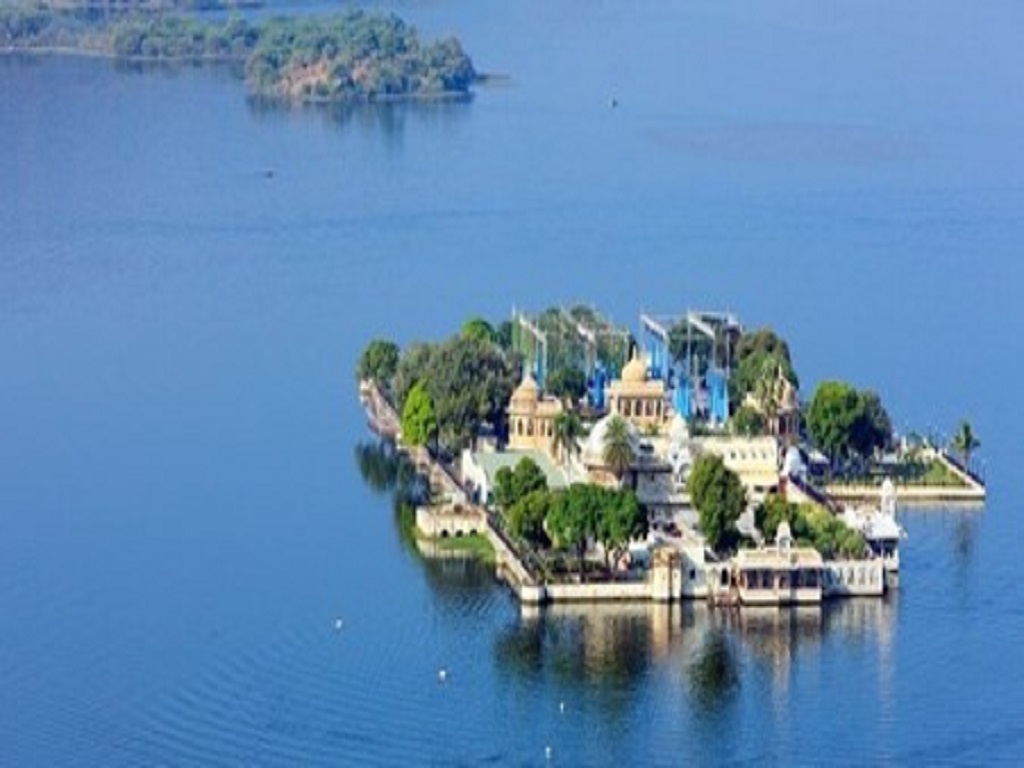
Classical India
- Home /
- India /
- North India /
- Classical India
India: One nation countless destinations
~ The ancient land of mystery, palaces and kings, romance and intrigue, nobility and grandeur. A land steeped in a tradition of services and privileges to royalty.
Despite its paradoxes and frustrations, India remains an utterly compelling destination. See life in its crowded bazaars, the unending ‘filmi’ music, the pungent mélange of cooking spices, beedi smoke, and dust and cow dung. Either you will love it or hate it but one thing is certain India is sure to change the way you see the world
Heart of India never ceases to amaze, its diversity offers you everything you would ever want in a holiday.
Itinerary In Detail
-
Day 01: Arrive Delhi
You will arrive at New Delhi’s International Airport. Following customs, immigration formalities and baggage collection, Our Team will meet you as you Exit the Arrivals Terminal building.
Warm Indian Welcome followed by transfer to the Hotel.
India’s capital and a major gateway to the country, contemporary Delhi is a bustling metropolis, which successfully combines in its folds – the ancient with the modern. Amidst the fast spiraling skyscrapers the remnants of a bygone time in the form of its many monuments stand as silent reminders to the region’s ancient legacy. The first impressions for any visitor traveling in from the airport are of a spacious, garden city, tree-lined with a number of beautiful parks
Upon arrival at the hotel, you will be accorded with a Traditional Welcome. Welcoming guest is an age-old tradition. ‘Atiihi Devobhava’ – treat your guest as if he were God. Indian hospitality can be savored immediately as one arrives at the hotel. Ladies dressed in traditional attire and colorful costumes greet the guest with garlands of fresh flowers. Flower petals are showered on the guest s and the ‘aarti’ ceremony is performed. The guest’s forehead is anointed with the traditional red ‘tika’ which is considered auspicious.
Check-in at exclusive desk set up at the hotel. Registration and pre-check-in will be arranged and guest will be escorted to rooms, after serving a non-alcoholic welcome drink.
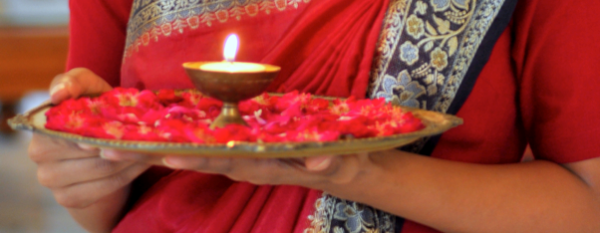
Overnight at Hotel
-
Day 02: Delhi
Morning proceed for the visit of Old Delhi – visit the resplendent “mosque of Friday” – Jama Masjid. Jama Masjid is the largest mosque in India and is one of the last architectural works of the Mughal emperor Shah Jahan – whose best work is the Taj Mahal. The spacious courtyard of the Jama Masjid holds thousands of faithful devotees. After visit of Jama Masjid Walk through the colorful shopping bazaar known as Chandni Chowk (“Moonlit Street”), enjoy Rickshaw ride at Chandni Chowk. Drive past the Red Fort – a majestic Fort and an erstwhile seat of power – which encapsulates a long period of Indian history and its arts.
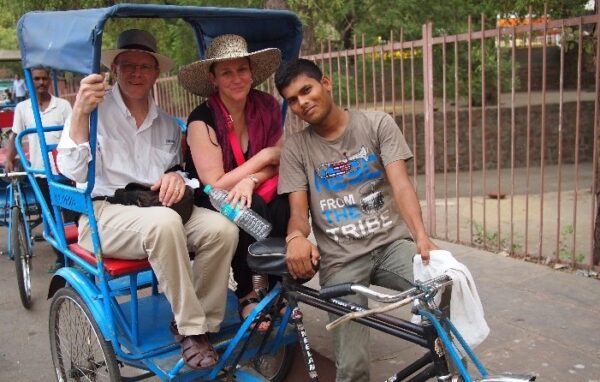
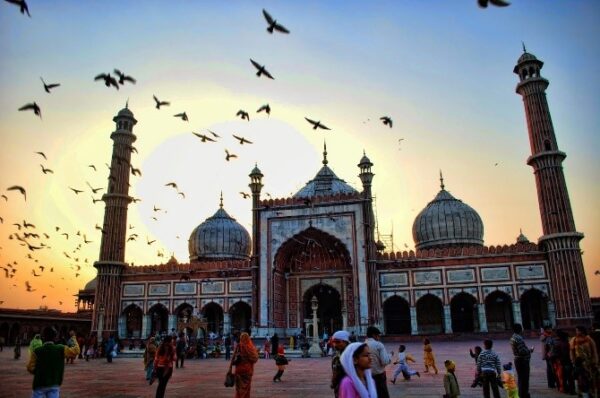
Also visit a Sikh Temple – Gurdwara Bangla Sahib – is the most prominent Sikh house of worship in Delhi. The temple is a grand sight. The sacred pond inside its complex, known as the “Sarovar”, contains water considered holy by Sikhs and is known as “Amrit”.
Lunch at local restaurant.
After Lunch, proceed for the Orientation tour of “Lyutens” Delhi – named after the leading British architect Sir Edwin Landseer Lyutens. Drive past some of magnificent monuments designed by him such as India Gate and Viceroy’s House – now known as the Rashtrapati Bhavan (President Palace).
Also visit, Qutub Minar, the pride of Delhi. The Construction of this tall minaret was commenced by Muslim ruler, Qutb-ud-din Aibak in 1192 and completed by Iltutmish. The soaring conical tower is an exquisite example of Indo-Islamic Afghan architecture. Humayun Tomb, is the Delhi’s first Mughal mausoleum, constructed in 1564 after the death of the second Mughal Emperor. It was built in accordance to the Indo Islamic architecture.


Dinner & Overnight at Hotel
-
Day 03: Delhi - Jaipur
After breakfast, check out and drive towards Jaipur
On arrival at “Pink City – Jaipur, transfer to the hotel.
Jaipur – the capital of Rajasthan province is known for its arts and crafts, jewellery, hand-painted fabrics and stone sculptures; it is one of North India’s finest examples of a planned city embodying the best of Rajput and Mughal architecture.
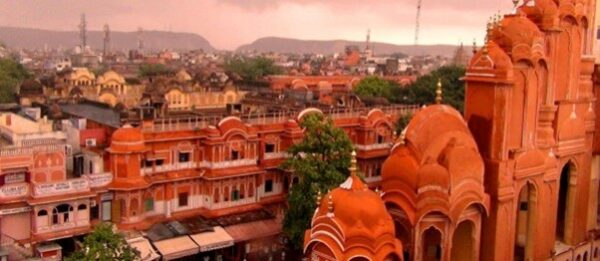
Arrive & check –in at the hotel.
Early evening proceed to Nahargarh Fort to capture take the overview of Jaipur City during sunset.

Nahargarh Fort, also known as Tiger Fort, is perched high on the rugged Aravali Hills overlooking Jaipur city. The fort was built 1734 to help defend the city. It found fame in 2006, after many scenes from the movieRang De Basanti were filmed there. Nahargarh Fort offers spectacular views, which are best seen at sunset. The fort looks particularly attractive at night when it’s lit up.
Return to the Hotel.
Dinner & Overnight at Hotel
-
Day 04: Jaipur
After breakfast proceed for excursion to Amber Fort, the former seat of the Rajput rulers of Jaipur. Enroute you will stop at the Palace of Winds for a photo opportunity. Continue your drive to Amber fort. Amber Fort, set in picturesque and rugged hills is a fascinating blend of Hindu and Mughal architecture.
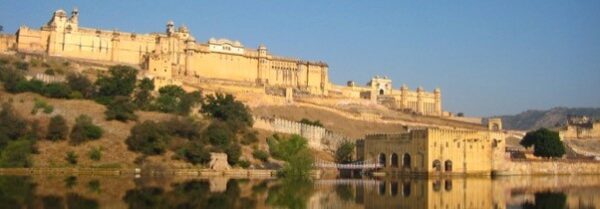
Enjoy Lunch at 1135 AD RESTAURANT, Amber Fort (OPTIONAL)
The name 1135 AD, Amber for this heritage restaurant, also indicates the year of inception of the Amber Palace. It is part of the old palace located next to the temple of Shila‐Mata‐goddess Durga and Singh pole‐the main entrance of the Palace. The restaurant has various sections and designed to cater to individuals, couples, small groups and corporate meets. The interior is Royal Rajasthan, matching to the rest of the palace. The wall paintings, gold and silver fixtures, furniture and artifacts replicate the old royal arena. Production and service staff have been trained to meet this specific and desired expectation. Menus can be compiled with authentic dishes as per individual requirement.
Later explore the city of Jaipur.
Visit City Palace, a beautiful palace complex full of treasures now housed in the museum area. City Palace is a delightful blend of Mughal and traditional Rajasthani architecture. It houses the Chandra Mahal, Shri Govind Dev Temple and the City Palace Museum. Also visit Jantar Mantar or Royal Astronomical Observatory. This observatory is a collection of architectural astronomical instruments, built by Maharaja (King) Jai Singh II at his then new capital of Jaipur between 1727 and 1734. Each instrument has a specific purpose and gives an accurate reading.
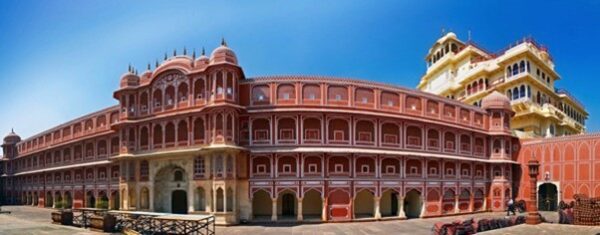
Get on the Rickshaws waiting outside the palace and we take you for a Ride to the colourful bazaar passing through the rose pink residential and business areas of Jaipur.
Evening visit Birla Temple – A Hindu Temple constructed in white marble. The presiding deities here are Vishnu (One of the Hindu Trinity Gods) called Narayan and his consort Lakshmi, Goddess of wealth and good fortune. The temple exterior has carved sculptures of various mythological themes and images of saints. Built on raised ground, it is surrounded by large lush green gardens
Afterwards return to the hotel.
Dinner & Overnight at Hotel.
-
Day 05: Jaipur – Agra
After Breakfast, Check-out after breakfast and drive to Agra (approx. 5 hrs),
In terms of ambience, Agra is still associated with its Mughal period. The Mughals besides being great rulers were also great builders and they preserved their best architectural wonders for Agra & its neighbourhood.
Arrive at the hotel and check-in.
After Lunch, visit the impressive Agra Fort, the seat and stronghold of the Mughal Empire for successive generations. The buildings within this sprawling fort complex represent the assimilation of different cultures, which was the mark of the Mughal period. Most of the structures within the Agra fort are a mixture of different architectural styles.

Evening visit Taj Mahal from afternoon till sunset.
The Taj Mahal, perfect in its symmetry, is a monument to the love of Emperor Shah Jahan for his wife Mumtaz Mahal. The construction of the Taj Mahal started in 1631. It took 20,000 artisans 22 years to complete this poignant mausoleum that blends subtlety with grandeur, and a massive overall design with immaculately intricate execution. On the inner walls, jewel-like stones create beautiful designs in white marble. The Mughals perfected the art of embedding semi-precious stones into marble and the Taj is the finest example of this; it is a special process called pietra dura.
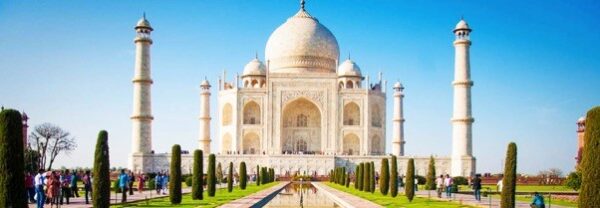
Evening return to the Hotel.
Dinner & Overnight at Hotel.
-
Day 06: Agra – Jhansi by Shatabdi Ttrain 0802/1045 hrs. / Jhansi - Khajuraho by Surface: 187 kms. / 4 hrs.
Breakfast at the hotel.
Later, you will be transferred to Agra railway station to board the train for Jhansi.
Arrive at Jhansi railway station and upon arrival transfer to Orchha.
Afternoon visit Orchha Fort, Situated on the banks of the River Betwa, Orchha is set amongst a wonderful complex of well-preserved 16th century temples and palaces.
Lunch at Amar Mahal.
Later continue drive to Khajuraho by surface. Upon arrival check in at Hotel which overlooks the western group of temples.
Khajuraho was once the religious capital of the Chandela Rajputs, a Hindu dynasty that ruled this part of India from the 10th to the 12th centuries. The Khajuraho temples were built over a span of a hundred years, from 950 to 1050, with the whole area enclosed by a wall with eight gates, each flanked by two golden palm trees. There were originally over 80 Hindu temples, of which only 22 now stand in a reasonable state of preservation, scattered over an area of about 21 km² (8 square miles).
Dinner & Overnight at the Hotel.
-
Day 07: Khajuraho – Varanasi
Breakfast at the hotel.
Morning proceed for city tour – Western & Eastern Temples.
The tour of Khajuraho will concentrates on the famous erotic temples, which represent some of the finest examples of temple architecture in Northern India. The remote location of Khajuraho meant that the temples were unharmed by Muslim invaders and as a result, the intricately fine carvings are in very good condition and are said to represent life in heaven. They were built during the mighty
Chandela dynasty; the majorities were constructed in a sudden burst of creative and religious energy, between the mid-10th and 11th centuries. After ruling for about 500 years the Chandela dynasty fell to the might of Islam and consequently the religious centre of Khajuraho was abandoned. The temples remain as a reminder of a society that believed in the full enjoyment of life, with all the senses being a path to nirvana. Of the eighty-five original temples only 22 remain, but many are in very good condition. You visit the Kandariya Mahadeva, the Chatrabhuj, Parswanath and Ghantai Temples, each remarkable for its beautiful design and architecture.

After Lunch, you will be transferred to the airport to board flight for Varanasi.
Fly Varanasi by 9W-370 : 1410-1505 hrs.
“Benaras is older than history, older than tradition, older even than legend…” – Mark Twain. Varanasi (Kashi), one of the holiest pilgrimage sites of Hindus, is believed to have the powers to grant ‘Moksha’ (nirvana). The holy river Ganges, in Varanasi, is believed to have the powers to wash away all the sins of mortals.

Upon arrival, transfer to the your hotel
Dinner & Overnight at Hotel.
-
Day 08: Varanasi
Early in the morning enjoy boat ride in the River Ganges. At sunrise the Hindu faithful flock to the river to cleanse themselves of their sins. You see the cremation ghats and the Deswameedha ghats. To die in Varanasi is to end the Hindu cycle of re-birth, thereby making it a popular place to end one’s life.

After sunrise you will visit some of the temples in the surrounding areas including Indian wrestling grounds known as “ Akharas”, Goshalas ( cow shelters) and colorful bylanes.
Return to the hotel for breakfast.
Relax in the hotel.
Afternoon proceed to visit Sarnath – Buddha, after attaining Nirvana, delivered his first sermon (now termed as Dharamachakara Pravartan) in Sarnath to set in motion the great Buddhist tradition of the Sangha. Dhamekh Stupa signifies the “Seat of the Holy Buddha”. Sarnath also has the ruins of Dharmajajika Stupa and of the original Mulgandhakuti Temple which, according to Hieun Tsang, was about 61 mtrs high.
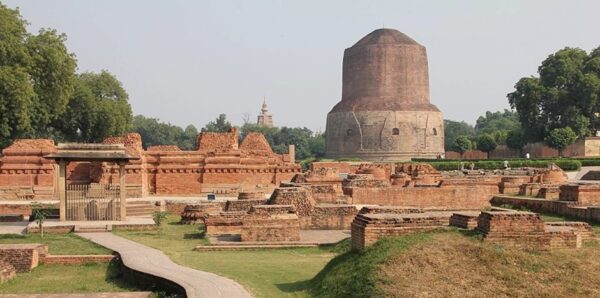
Evening walk towards Dashashwamegha Ghat (the Bank of river Ganges) to witness Aarti of river Ganga, where you will see the Hindu devotees performing the “Puja” with lighted lamps.
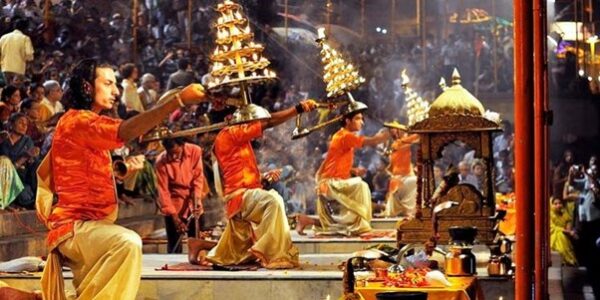
Dinner & Overnight at Hotel.
-
Day 09: Varanasi - Delhi
Today in the morning enjoy Yoga Session.
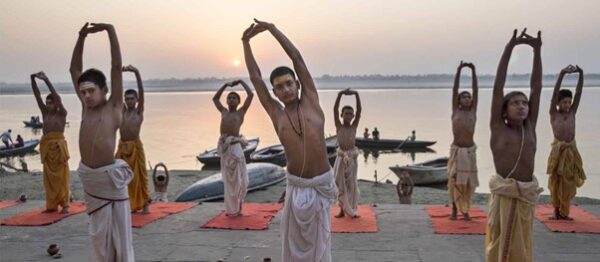
After breakfast, check out and transfer to the airport to connect flight to Delhi
Upon arrival in Delhi, proceed to visit Akshardham temple complex –
Nestling on the banks of river Yamuna over 100 acres of land, the temple is a modern signature of exquisite beauty. “Akshardham” means the eternal, divine abode of the supreme God, the haunt of eternal values and virtues of ‘Akshar’ as defined in the Hindu texts where a heart of devotion, purity and peace forever perches. The temple affords a beautiful matrix of marble and red sandstone, with many alluring sculptures that embellish its periphery. Come, experience divinity rising before your eyes at Akshardham, where a religious poetry is offered to every individual heart.

Also visit the different Exhibition halls and take the boat ride named Sanskruti Vihar, which would take you on a journey through 10,000 years of Indian history in approximately 12 minutes.

Later visit Shopping mall.
Afterwards, transfer to International Airport to connect flight to back home.
9 Days From

Any Question?
Feel free to call our travel experts.
+977 9851189018, +977 9801089018
info@asiaticroads.com
9 Days From

Any Question?
Feel free to call our travel experts.
+977 9851189018, +977 9801089018
info@asiaticroads.com
9 Days From

Any Question?
Feel free to call our travel experts.
+977 9851189018, +977 9801089018
info@asiaticroads.com
Reviews
In my 2 week stay, John was very professional and took me around to experience all that Kathmandu and surrounding areas has to offer. Sites were seen and many locals were met through John’s network.

Steven Stone
TravellerIn my 2 week stay, John was very professional and took me around to experience all that Kathmandu and surrounding areas has to offer. Sites were seen and many locals were met through John’s network.

Steven Stone
Traveller9 Days From


